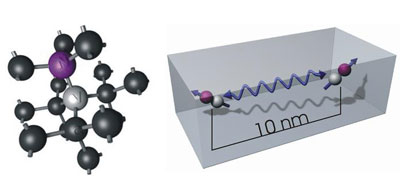| Posted: March 1, 2010 |
Another step towards quantum computing: coupling of nitrogen centers in a diamond |
|
(Nanowerk News) Another decisive step forward in the development of quantum computers has been successful. For the first time ever, researchers at the Ruhr University in Bochum, the Universities of Stuttgart and Austin /Texas (USA) have accomplished to place two nitrogen atoms in a distance of only few nanometers, so that laser excitation will be capable of creating a quantum mechanical coupling. The key to the solution: it works with high precision, reliably, and even at room-temperature only in a diamond. The scientists reported their results in the noted journal Nature Physics ("Quantum register based on coupled electron spins in a room-temperature solid").
|
 |
| NV centers are immobile in the surrounding carbon lattice. When targeted by a laser, the two nitrogen centers will react.
|
|
Why diamonds?
|
|
The research results confirm a hypothesis on the special properties of diamonds which has been put forward by the Stuttgart scientists Prof. Dr. Jörg Wrachtrup and Dr. Fedor Jelezko several years ago: color centers or NV centers are immobile in the surrounding carbon lattice - whereby N stands for nitrogen and V for a vacancy. Since there is actually no "diffusion" inside a diamond, the atoms won't migrate back and forth. When targeted by a laser, the two nitrogen centers will react and a manipulable superposition of their spin states - the rotational movement of electrons - results. These highly complex studies were conducted in Stuttgart.
|
|
Simultaneous multiple states
|
|
Spin up - spin down: these are primarily the two states the coupled atoms can assume, comparable with "0" and "1" in a computer. However, the processes in this quantum "circuit" are much more sophisticated. "Microscopical and quantum mechanical systems prepared this way differ totally from our everyday experience and can take on, for example, several states at one and the same time," says Jan Meijer. "You can almost compare them with two conventional PC memory devices coupled in such a manner that they interfere with each other."
|
|
Quantum computer: the first step is made
|
|
That the coupling of the atoms in the diamond's color center even works at room-temperature is the crucial requisite for building a quantum computer. Meijer: "Basically it is imaginable and possible to create several of these NV centers deliberately by means of ion implantation, couple them together in a scalable fashion and have a classical computer control it all." The number of couplings is now to be increased step by step. "This is a great challenge," says Meijer, "because the greater the number of couplings, the faster the system will fall apart."
|
|
Unlimited possibilities
|
|
The possibilities are - theoretically - immeasurable: if we were to connect only 100 of these NV centers with each other, we would get two to the power of 100 coupled memory cells. "Physically, this is considerably more than we need to store the entire knowledge of humankind," as Dr. Meijer explains the dimensions. A totally new computer technology can be built by applying the laws of quantum mechanics - with it, we could, for example, calculate the properties of complex biological molecules or crack codes within a fraction of a second.
|

